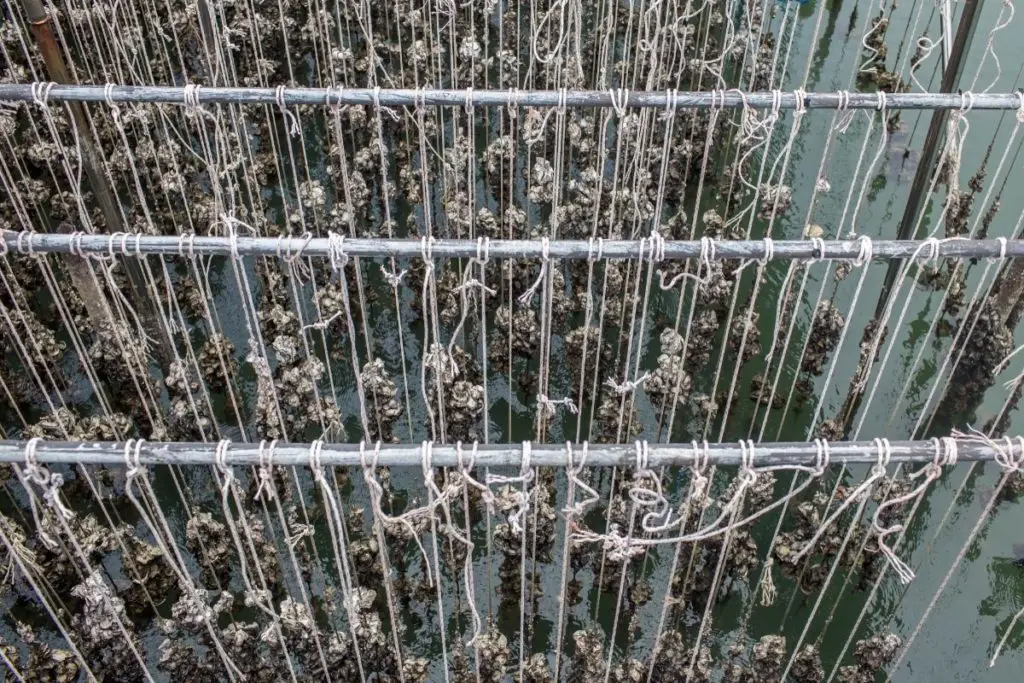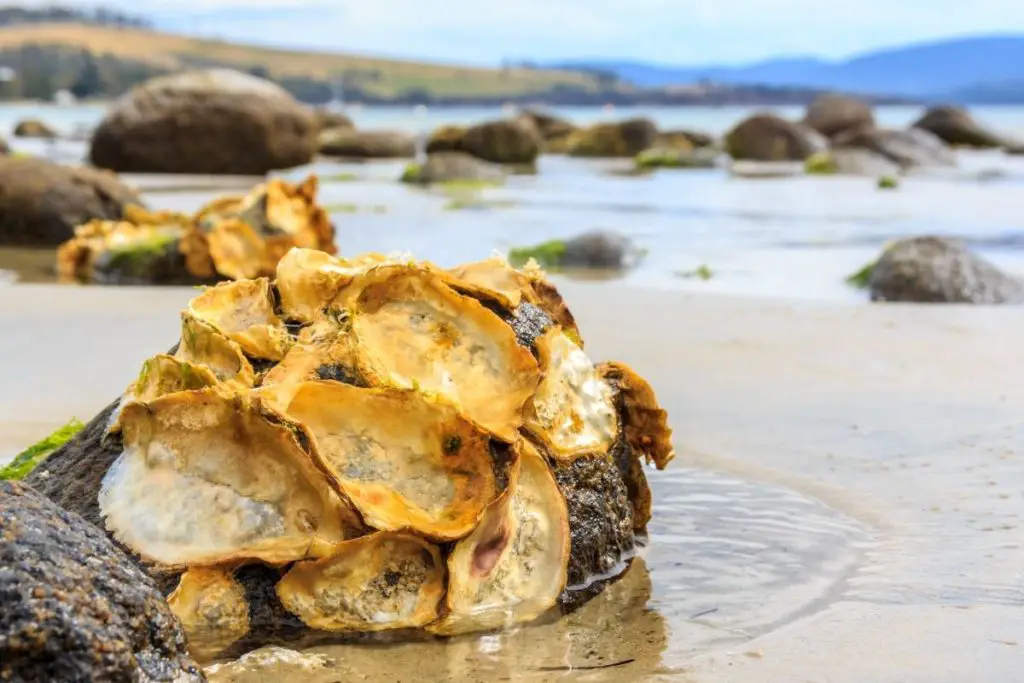Oysters are a delicacy that some people love, while others hate. These salty bivalve mollusks are actually packed with healthy nutrients, such as a lot of zinc, which is what makes them known as an aphrodisiac. Zinc boosts your sex drive, while also helping your immune system.

The oysters that we eat are either farmed, or harvested from the wild, and there are a lot of questions floating around about which is healthier. Farmed fish has a reputation for being known as less healthy, but is this the case with oysters?
This article will be discussing the difference between both forms, so you know what is going on your plate.
What Are Oysters?
Before we get into this debate, let’s cover some basics. What are oysters exactly?
They are bivalve mollusks, which are aquatic mollusks with a symmetrical, two-sided shell. There are several of these species around, and other mollusks include clams, scallops, and mussels.
Some oysters can produce pearls, but this is not the species we tend to eat. Edible oysters are part of the ostreidae family, while the ones that produce pearls belong to the pteriidae family.
These little animals will cluster themselves onto any hard, submerged surface, such as rocks, piers, and older shells. They are filter feeders, meaning they open up their shells to allow water to pass through their gills, providing them with oxygen and food.
Oysters also hold ecological value, as they have water purifying properties as they filter and remove pollution from our seas. One oyster can filter up to a whopping 50 gallons of water a day!
Unfortunately, many of their reefs have been destroyed due to overfishing, but their beneficial properties to the ocean are being recognized, and many areas are now seeding and growing them to reduce nitrogen levels in the ocean.
How Do You Eat Them?
There are many myths and misconceptions about how you should eat oysters. Traditionally, they were eaten raw, straight from the shell, and slurped down.
In more recent years, there has been a growing concern about the safety of this, due to certain bacteria, the most common one being, vibrio vulnificus.
These bacteria can naturally inhabit coastal waters where oysters live, and as these oysters filter the water, the bacteria can get caught on their tissues. If someone eats a raw oyster that has been contaminated with these bacteria, it can cause them serious illness.
While these bacteria can contaminate oysters any time of the year, it is more likely to happen during the warmer months, when seas have a warmer than average temperature.
Companies that harvest oysters have strict guidelines in place to prevent illness in those who consume them raw. They make sure to harvest them properly, ensuring to cool them to a 45-degree temperature that is maintained until they are served.
Keeping them cold keeps them safe to eat, and making sure you have obtained them from a good supplier, or a good restaurant is the best way to consume them safely.
This is where the argument around farmed or wild oysters comes in, as farmed oysters are controlled and given access to certain food sources that keep them healthy. More on that a little later.
If the idea of eating raw oysters makes you uneasy, you can cook them easily. You can grill, fry, or steam them, and they don’t take long to cook. You just need to make sure they don’t overcook, as this can make them tough to eat.
Farmed Oysters
As we mentioned earlier, there has been a common perception that farm-raised seafood carries risks to consumers and has an environmental impact. While this may be true for some seafood, it is a generalization that does not bear truth when it comes to oysters.
Oysters are farmed in their natural habitat, out in the wild, and as they do not need to be fed, they eat the same foods as wild oysters. These come from tides and waters that are rich in algae.
Rather than separate them from their environment, oyster farmers will protect them from predators by using oyster cages. Some will also use a bottom-plant technique. This is where they help the oysters grow on the floor of the ocean as wild ones do.
Many wild oyster fisheries have been destroyed due to overfishing, but the growth of oyster agriculture has allowed wild oysters to recover and repopulate, reducing the need for wild oysters.

Critics will state that these kinds of aquaculture have negative impacts on the environment, but due to oyster’s ability to purify the ocean, this point does not relate to oysters. As stated earlier, a single oyster can purify 50 gallons of water, so growing more oysters is beneficial for our ocean.
Oysters that have been farmed, have farmers looking after them, making sure they are growing well. This makes oysters produced by farmers more consistent, which is great when it comes to shucking them (opening them up).
Wild Oysters
As the name suggests, wild oysters are out in the wild, on their own, without anyone looking out for them. These oysters tend to grow slightly slower than farmed ones,
but this allows their shells to harden more, giving them more time to grow more meat. This means that wild oysters may have a little more meat inside.
As there is no consistency with these oysters, some can be a little rough around the edges, looking less presentable than farmed oysters.
While wild oysters still have all the ecological properties that farmed ones do, pollution of the ocean means you need to be wary of their location, as they can pass on bacteria to consumers.
Are Wild Or Farmed Oysters Better?
Both kinds of oysters have positives and negatives, but one is not better than the other. While farmed oysters are more consistent and can produce bulkier batches, wild oysters can sometimes produce more heat.
However, these do take longer to grow, whereas farmed ones can provide restaurants and companies with a hefty supply within 18 months.
When it comes to chefs, there generally is no preference for farmed or wild oysters. They just prefer good quality oysters that have a good meat content and a good flavor, which can both be obtained from both farmed and wild oysters.
95% of the oysters you find in restaurants are farmed, so it can become a very common form of aquaculture. They are bred to grow quickly, so many can be supplied, keeping the oyster market thriving.
Final Thoughts
This article has covered all things oyster! From what they are, to how they should be eaten, and the difference between wild and farmed ones.
When it comes to consuming them, if you choose to eat them raw, you must be mindful of the harmful bacteria that can be present in them.
This goes for all raw fish. Oysters are purifiers of the sea, so if they consume any harmful bacteria, that can be passed onto you when you eat them raw.
However, as they are bred and controlled in their farms, the risk of this bacteria growing is slightly less likely than in wild oysters.
To reduce this risk, you can cook them in a number of ways such as frying or grilling, and they are just as tasty.
As to whether farmed or wild oysters are better, it all comes down to personal preference, but farmed oysters are more commonly used when it comes to cuisine.
